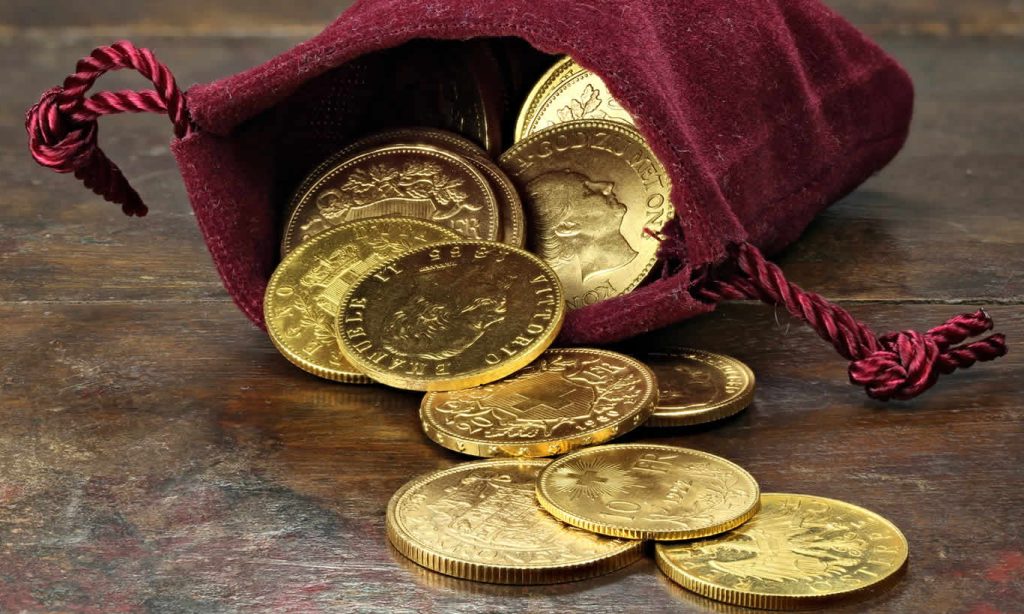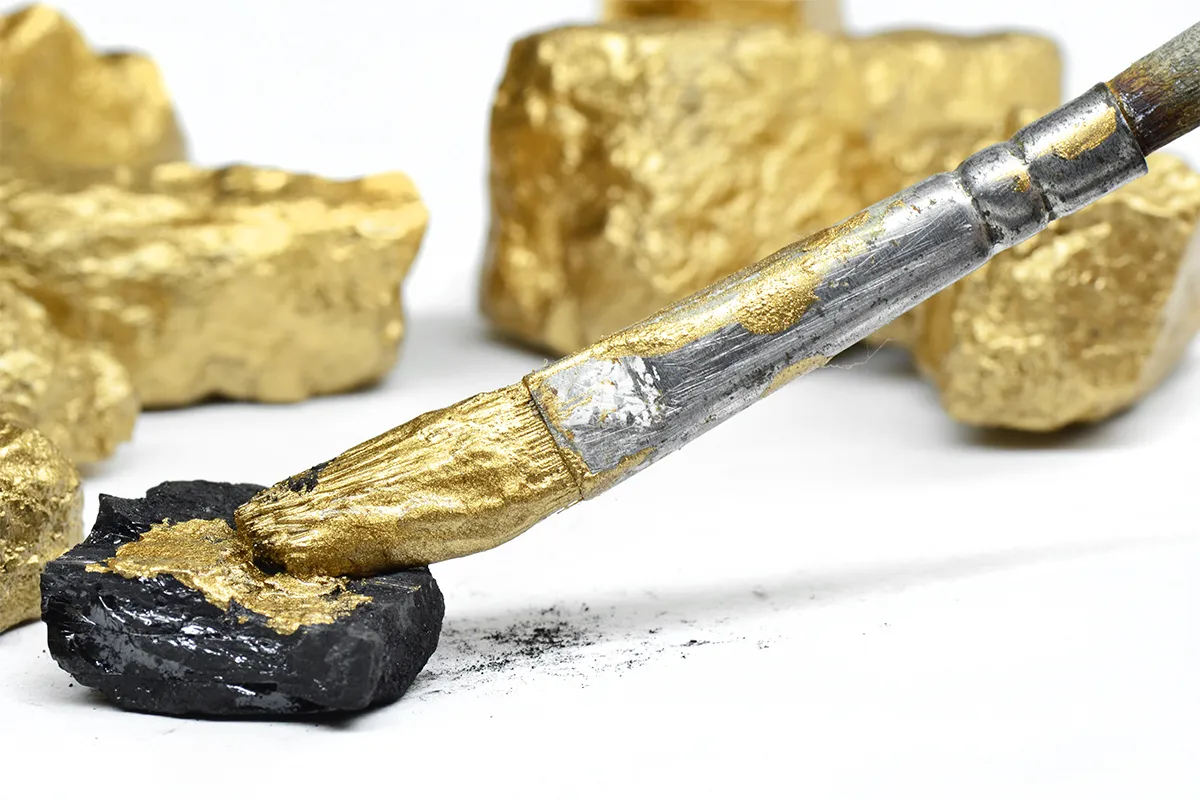Here are the 9 best ways to spot fake gold
Are you wondering about how to identify gold at home or in the physical gold market, how to spot fake gold chains? Well, we bring you the best 9 ways to spot fake gold material.
It is important for any gold investor or collector looking to enter the gold market to be equipped with the basics techniques of how to spot fake gold as the value of gold and its worthiness on the global market has extensively led to the production of counterfeit products.
Spotting fake gold from pure gold will require you to have a combination of both practical tests and observational skills. There are a lot of ways to spot fake gold and some of these include;

How to spot fake gold ?
Check for Hallmarks and Stamps
Authentic gold jewelry and bars usually come with a hallmark or stamp indicating the gold’s purity and the manufacture’s details. Common stamps you will sight on them include 24K, 22K, 18K, 14K representing gold’s purity level and 999, 916, 750, 585 representing gold’s purity in parts per thousand.
With help of a magnifying glass, examine the hallmark to ensure that it is clear and well defined. Fake gold will often have something missing on it
Conduct a Visual Inspection
Gold has a distinct color and shine that doesn’t tarnish or lose its color over time making it very difficult to replicate. Genuine gold items have a consistent and warm yellow hue.
Look for any discoloration or tarnish, especially in areas where the item is frequently handled or rubbed. Fake gold may reveal a different metal underneath if it is only gold-plated.
Perform the Magnet Test
Gold is not magnetic. But since different metals are combined to make fake gold, when you hold a magnet closer, it will get attracted.
What you have to do is to conquer the gold market with your magnet, hold it very close to the gold you want to buy, if even a single piece gets attracted, that will prove that some metal elements have been added to it hence it is not pure.
Use the Float Test
Pure gold is dense and will sink in water. Fill a container with water and gently place the gold particles inside. If they float or hover, that means they might be fake mixed with other less dense metal elements.

Conduct a Scratch Test
You have to be extremely very careful when performing this test as it can damage the gold item instantly. You will gently scratch the gold piece on a ceramic plate or a piece of unglazed porcelain. Fake gold will leave a black or green mark while pure gold will leave a gold streak.
Test with Nitric Acid
This test should be carried out by an expert as nitric acid is corrosive, it is very harmful and can cause serious damage.
A small drop of nitric will be will be put on the gold, if it is fake, it will react by turning green or any other color. genuine, pure gold doesn’t react to nitric acid.
Use an Electronic Gold Tester
Electronic gold testers are devices designed to measure the gold’s authenticity and purity. These devices provide a quick and accurate assessment and are widely used by jewelers and gold dealers.
Check for Weight and Size
Gold is a dense metal, so it should feel heavy for its size. Compare the weight and size of the item with a piece of gold that is known to be genuine. Fake gold items are often lighter compared to their size.
Seek Professional Appraisal
Whenever in doubt, always seek advice from a professional gold jeweler or gold dealer. They have the expertise and well equipped with the necessary tools required to verify the authenticity of gold accurately.
The above methods of spotting fake gold can as well be used to identify gold at home.
How to test Gold with a Lighter?
Heat a gold piece with a lighter for about 60 seconds. Ensure that the flame touches it directly as you carefully observe the reaction.
When you observe that the gold piece has remained unaffected or it has slightly brighten due to the removal of any superficial dirt or oil, then know that its real. Real gold is the one that does not tarnish, discolor, or react to the heat. A fake gold may darken, change color, or emit a greenish tint when heated.
Types of fake Gold
There are several types of fake gold to be aware of while in the gold market, especially if you’re considering purchasing gold jewelry or coins. Here are some common types of fake gold:
- Gold-Plated Items: These have a thin layer of gold applied to a base metal. Over time, the gold layer can wear off, revealing the base metal underneath.
- Gold-Filled Items: Gold-filled jewelry contains a thicker layer of gold bonded to a base metal, but it’s still not solid gold. The gold content is usually at least 5% of the total weight.
- Vermeil: This is a specific type of gold plating on sterling silver. It must have a gold layer of at least 10 karats and be at least 2.5 microns thick.
- Brass or Gold-Like Alloys: Some items may be made from alloys that resemble gold in color but contain no gold at all. These can tarnish over time.
- Costume Jewelry: Often made from inexpensive metals and coated with gold paint or other finishes, these items are not valuable and can easily be mistaken for real gold.
- Fake Coins: Counterfeit gold coins can be made from cheaper metals which are then coated in gold or created to look like gold coins yet in actual sense don’t have any value.
- Gold-Color Plating: These are items that are simply coated with gold-like finishes that are not real gold at all.
To avoid purchasing fake gold, always buy from reputable sources and consider having items appraised by a professional.
Frequently Asked Questions About Spotting Fake Gold
1. How can I tell if gold is real or fake?
You can check if gold is real using these methods:
- Magnet Test – Real gold is not magnetic. If it sticks to a magnet, it’s likely fake.
- Acid Test – Use nitric acid to test purity (real gold won’t react).
- Scratch Test – Gold is soft and won’t scratch easily; fake gold may show a different metal underneath.
- Float Test – Real gold sinks in water, while fake gold may float.
- Sound Test – When dropped, real gold makes a soft, deep sound, while fake gold produces a tinny noise.
2. Can fake gold pass a magnet test?
Yes, some fake gold alloys are non-magnetic, which can fool basic tests. That’s why you should combine multiple tests (acid test, weight check, etc.) to confirm authenticity.
3. What is gold-plated jewelry, and how is it different from real gold?
Gold-plated jewelry is made of a base metal (like copper or brass) with a thin layer of gold. It looks real but wears off over time, exposing the base metal underneath. Solid gold doesn’t wear away.
4. How can I check gold purity at home?
You can:
- Use a gold testing kit (acid or electronic tester).
- Look for hallmarks (e.g., 24K, 18K, 14K).
- Rub gold on a ceramic plate – real gold leaves a gold streak, while fake gold leaves a black streak.
5. Can real gold change color or tarnish?
Pure gold (24K) does not tarnish or change color. However, lower-purity gold (10K, 14K) can tarnish due to mixed metals like copper or nickel. If your gold turns green or black, it may be fake or low-quality.
6. Do fake gold sellers mix real and fake pieces?
Yes, some scammers mix real gold with fake pieces to deceive buyers. Always test each piece individually before purchasing.
7. How do I avoid buying fake gold in Africa?
- Buy from licensed dealers or refineries.
- Verify with a gold purity testing lab.
- Avoid street vendors or overly cheap deals.
- Request proper documentation and receipts.
8. Can fake gold be made to look exactly like real gold?
Yes, counterfeiters can create high-quality fake gold using alloys like tungsten, which has a similar density. This is why weight, acid testing, and professional verification are crucial.
9. What is fool’s gold, and how is it different from real gold?
Fool’s gold (pyrite) is a shiny, yellow mineral that looks like gold but is much lighter and brittle. Unlike real gold, pyrite shatters when struck and does not have the same weight or softness.
10. Should I get my gold tested professionally?
Yes, if you are making a large purchase, it’s best to visit a certified gold testing center to confirm authenticity.


